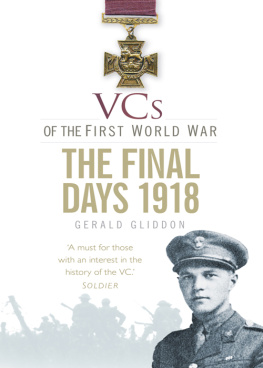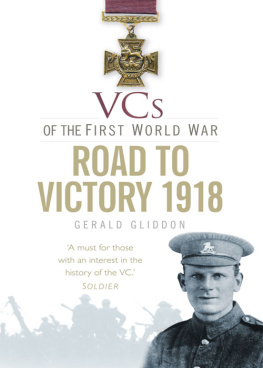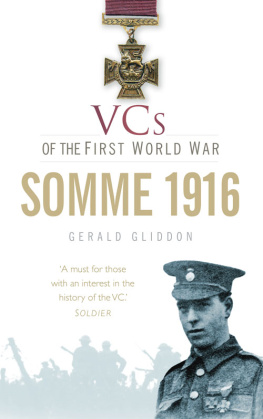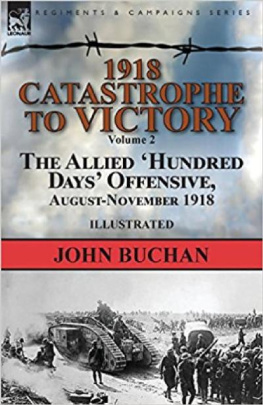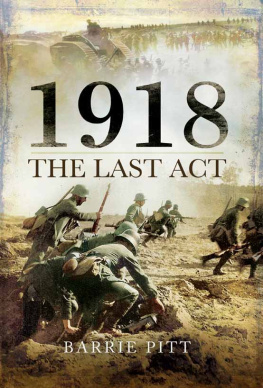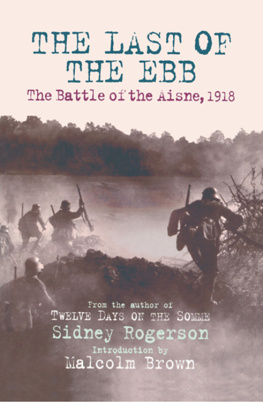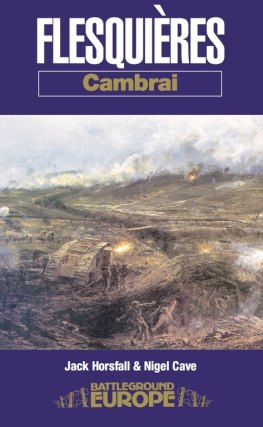C ONTENTS
I would like to thank the staff of the following institutions for their assistance during the research for this book: the Commonwealth War Graves Commission; the Imperial War Museums; the National Army Museum; and The National Archives. In addition, I would like to thank the archivists and curators of the many regimental museums and libraries who have replied to my requests for information.
Where recently taken photographs have been used, their owners have been acknowledged with the individual illustration.
As with my previous books in the VCs of the First World War series, Donald C. Jennings of Florida has been very kind in allowing me to reproduce many pictures of either graves or memorials which appear in this book.
Many of the maps used have been taken from regimental histories or from the British Official History of the War: Military Operations in France and Belgium, 19141918, edited by J.E. Edmonds, Macmillan/HMSO, 192249.
Maurice Johnson once again spent many hours in The National Archives on my behalf, searching out and reading the appropriate War Diaries. Other individuals who have been of great help in many ways include Peter Batchelor, John Bolton, John Cameron, Jack Cavanagh, Colonel Terry Cave CBE, Barry Conway, D.G. Gage, Ray Grover, Peter Harris, Chris Matson, Dick Rayner and Steve Snelling. Other people who provided additional material but whose names are not mentioned here have been acknowledged in the list of sources at the end of the book.
The History Press have decided to re-issue the VCs of the First World War series in new editions and I have taken advantage of this decision by revising and updating the text of the current volume.
Since the initial research for this book was carried out fifteen years ago, there has been an increasing interest in and awareness of the stories and lives of the men who were awarded the nations and the Commonwealths highest military honour. Evidence of this can be found in the amount of new books being published on the subject: the reissuing of servicemens records by The National Archives and the accessibility of other records of family history, which are now available via the magazine Ancestry, and from other sources. The Internet has also played a major part, although information received using this method should always be verified by cross-checking. Finally, the founding of the Victoria Cross Society in 2002 by Bran Best has encouraged further research and publication of informative articles on the holders of the Victoria Cross.
While this book was being prepared, the British government announced plans to mark the First World War centenary from 2014 to 2018. One of the ideas is directly linked with the commemoration of men who had won a Victoria Cross during the Great War. For men born in the United Kingdom, a special paving stone will be installed in the town or district most associated with them. It is hoped that those men born overseas will also be commemorated in an appropriate manner. Finally it is hoped that all 628 VC recipients will be named at Heroes Square at the national memorial Arboretum in Staffordshire.
Gerald Gliddon, 2014
This book covers the final days of the war on the Western Front, from when the Allied Armies were poised to capture the Hindenburg Line to the Armistice on 11 November 1918. The last man to win the VC, covered in the previous volume Road to Victory, was Temporary Lieutenant (T/Lt) Donald Dean, 2426 September, and the opening section of this book tells the stories of seven men who received their Vcs for the part they played in the Battle of the Canal du Nord. From then until 6 November, a period of just under six weeks, a further forty-nine VCs were won in the victorious Allied advance. The last period of the war became a sequence of battles to capture a series of river lines; as each one was captured by the Allied armies, the German Army fell back to the next one.
The Third Army, to the right of the First Army, began the Battle of the Canal du Nord on 27 September. At the beginning of the war the canal was still unfinished in places and the Canadian Armys plan was to make use of these dry sections, thus avoiding the hardest parts of the line. Obtaining permission, the Canadian commander, Lieutenant General (Lt Gen.) Sir Arthur Currie, planned to make a crossing on a narrow front to the south, and, once across, to fan out. This turned out to be a great success and, despite the enemy putting up a stiff resistance, the British Third and First Armies advanced 6 miles. This success prepared the ground for the eventual capture of Cambrai.
On 29 September the Fourth Army began the Battle of St Quentin, which ended three days later after the Canal du Nord and St Quentin Canal had been taken. The key part of the operation at the St Quentin Canal was the capture of a section between Bellicourt and Vendhuille, where it went underground through a tunnel. A preliminary attempt failed, but was followed by a successful assault by the 46th (North Midland) Division. After storming the enemy defences at Bellenglise, the divisions Staffordshire Brigade, protected by fog, crossed the canal by footbridges which the enemy had neglected to destroy. Having reached the far bank, the division, together with the 32nd Division, moved to the right and began to outflank the enemy and to take the rear German defences.
On 3 October the Fourth and Third Armies began the Battle of the Beaurevoir Line, a substantial enemy support system which was part of the Siegfriedstellung (Siegfried Line). The battle lasted for two days. On 8 October these two armies, together with the French First Army, began an attack south of Cambrai on a 17-mile front. On the following day Canadian patrols entered Cambrai to link up with troops from the Third Army. However, the enemy then made a stand on a line along the River Selle, close to Le Cateau, which lasted two days. On 10 October the Battle of Flanders began, and on 14 October the Battle of Courtrai, lasting for four days. The important town of Lille fell on 17 October, and on the same day the Belgian Army retook the port of Ostend.
To the south, on 17 October, the Fourth Army began the Battle of the Selle, with the target of the SambreOise Canal as far as the prized town of Valenciennes. The battle began on a front of 10 miles to the south of Le Cateau, and the right of the Fourth Army reached the SambreOise Canal after three days. To the north, the Third Army crossed the Selle on 20 October. On 23 October the British Fourth, Third and First Armies combined and advanced a further 6 miles. Overall, the battle lasted eight days. To the north, the Fifth and Second Armies were progressing towards the Scheldt line.
This Allied progress was not achieved without considerable cost; in October, after the fall of the Hindenburg Line, the British suffered 120,000 casualties. The German casualties were also considerable and, in addition, about a quarter of their army surrendered. On 1/2 November the First and Third Armies fought the Battle of Valenciennes, and on 4 November the Battle of the Sambre began. With the support of thirty-seven tanks, the British First, Third and Fourth Armies advanced on a 30-mile front from Valenciennes to the SambreOise Canal, either side of the Forest of Mormal. Early on 11 November the Canadian Corps retook Mons, and after the signing of the Armistice at 11 a.m. the guns finally fell silent.
Canal du Nord, Near Graincourt, France 27 September

No fewer than seven VCs were won on 27 September 1918 at the beginning of a four-day campaign to capture the Hindenburg Line with the crossing of the Canal du Nord. The success of the whole operation proved to be of great significance, enabling the Allied armies to make further rapid advances and directly leading to the Armistice six weeks later.
Next page
